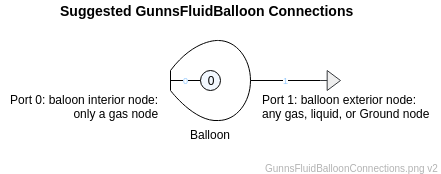GunnsFluidBalloon - nasa/gunns GitHub Wiki

This link extends GunnsFluidTank to model a gas inflatable balloon or air bag. It has all of the features and user edit capabilities of the tank class, and also models a stretchy wall that becomes rigid at a given maximum volume.
The balloon interior volume and delta-pressure between the interior and exterior pressures always follows this simple relationship:
When the product of delta-pressure and inflatability constant would result in a volume larger than the balloon's maximum volume, the volume is limited to the maximum, the wall goes rigid, and the balloon behaves exactly like a GunnsFluidTank.
All balloons have a minimum internal volume of 1e-12 m3. A low enough or negative delta-pressure limits the balloon to this minimum volume.
Limitations & Assumptions:
- This link makes extensive use of the ideal gas law assumption, and only ideal gasses should be used in the balloon's interior node. For liquids, use the GunnsFluidAccumGas instead.
- Assumes a constant inflatability ratio between volume and pressure, which is a simplification and isn't necessarily realistic. A real-world inflatable may have a non-linear relationship between pressure and volume depending on its wall material and construction. We leave it to a derived higher-fidelity balloon link to model the non-linearity, when needed.
- The volume that this balloon displaces from its exterior environment is not modeled. If the balloon's exterior node has a volume, the inflation of the balloon doesn't affect that exterior node volume.
- Because the balloon doesn't fully interact with its exterior node (it responds to external node pressure but can't displace external node volume), these balloons shouldn't be nested inside each other. They can be nested, but won't interact properly.
- This link doesn't model balloon popping or leaks. To model those effects, simply add leak or valve links in parallel with the balloon link.
The picture below shows the suggested way to connect a balloon. Port 0 is on the narrow side of the balloon shape (like the bottom of a hot-air balloon), and Port 1 is on the other side. Port 0 connects to the node representing the interior volume (node 121 in this example), and Port 1 connects to the exterior node. You can place the interior node inside the balloon shape, as in the example, or outside:

Port Connection Rules (These are limitations on the port connection to nodes that the link enforces in run-time):
- Port 0 can only connect to a gas-phase, non-Ground node.
- Unlike tanks and fluid capacitor links, Port 1 can connect to any node. This can be Ground or not, and can be any fluid phase.
Other Rules (These are extra rules you should always try to follow):
- Same as GunnsFluidCapacitor.
- The ambient node (Port 1) should not change pressure rapidly. Ideally this would be a constant-pressure node, such as Ground or an ambient boundary node, but the balloon link can handle slow changes to its pressure if needed.
Configuration Data Parameters:
- expansionScaleFactor: Same as GunnsFluidTank.
- dpdtFilterGain: Same as GunnsFluidTank.
- thermalDampingMass: Same as GunnsFluidTank.
- editFluxTarget: Same as GunnsFluidTank.
- surfaceArea: Same as GunnsFluidTank. Note that in reality, a stretchy balloon's surface area changes with volume, but we don't model that variation for this wall thermal conductance effect term.
- shellRadius: Same as GunnsFluidTank. Note that in reality, a stretchy balloon's internal radius changes with volume, but we don't model that variation for this wall thermal conductance effect term.
- inflatability (default = 0 m3/kPa, must be > 0): this is the inflatability term in the above equation. It controls how much the balloon volume changes in response to differences between the interior & exterior pressures. Higher values make the balloon stretchier: it inflates more for a given delta-pressure. Lower values make the the balloon more rigid.
- maxVolume (default = 0 m3, must be > 1e-12): this is the maximum volume of the balloon, at which point the wall suddenly becomes rigid. This can be used to simulate air bags that have a maximum inflation volume. If you don't want a maximum volume where the wall becomes rigid, simply set this value to a larger volume than your balloon would ever reach in your network.
Input Data Parameters:
- malfStuckFlag (default = false): This is the initial activation state (true = active) of the wall stuck malfunction. This malfunction makes the balloon rigid at its current volume.
- malfInflatabilityScaleFlag (default = false): This is the initial activation state (true = active) of the inflatability scale malfunction.
- malfInflatabilityScaleValue (default = false): This is the intial scale value of the inflatability scale malfunction. When active, the actual inflatability of the balloon becomes this scale factor multiplied by the default inflatability value.
- initialFluidState: Same as GunnsFluidTank. You don't set the initial volume directly. Instead, the initial volume is determined from inflatability and the initial node pressures in the network. This fluid state sets the initial internal node pressure.
- initialShellTemperature: Same as GunnsFluidTank.
- biasHeatFlux: Same as GunnsFluidTank.
- Same as GunnsFluidTank
- N/A